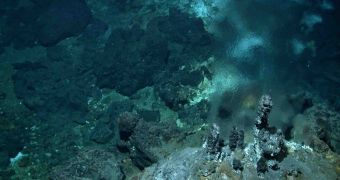A new hydrothermal vent has been discovered at 500 kilometers south-west of the Azores, by scientists from the MARUM Center for Marine Environmental Sciences and the Max Planck Institute for Marine Microbiology in Bremen, thanks to the equipment on board the German research vessel Meteor.
This new hydrothermal vent was found using the latest-generation multibeam echosounder on board the research vessel, because it allows an extremely precise imaging of the water column above the ocean floor.
So the researchers spotted a plume of gas bubbles in the water column, around 5km away from the large vent field Menez Gwen, where they were currently working.
They used the remote-controlled submarine MARUM-QUEST and discovered this new hydrothermal site, which included smokers and the animals that normally live near vents on the Mid-Atlantic Ridge.
This new discovery is extraordinary because the area in which it was found has been studied for a long time, during previous researches.
Driven by the excitement of the discovery, the scientists kept on searching the water column and came across five more sites with gas plumes, some of which lied outside the volcanically active spreading zone in areas where hydrothermal activity was considered nonexistent.
Dr. Nicole Dubilier, the chief scientist of the expedition said that the “results indicate that many more of these small active sites exist along the Mid-Atlantic Ridge than previously assumed, [and] this could change our understanding of the contribution of hydrothermal activity to the thermal budget of the oceans.
“Our discovery is also exciting because it could provide the answer to a long standing mystery: we do not know how animals travel between the large hydrothermal vents, which are often separated by hundreds to thousands of kilometers from each other.
“They may be using these smaller sites as stepping stones for their dispersal.”
This vent site has chimneys as high as one meter, temperatures up to 300 degrees Celsius and it's located at a depth of 1,000 meters, in the middle of the Atlantic Ocean.
The search for deep-sea hydrothermal vents in the Atlantic began September 6th, on board the German research vessel Meteor, with a team of 30 marine scientists from Hamburg, Bremen, Kiel, Portugal, and France.
In his video podcast Dennis Fink, a doctoral student at the Max Planck Institute for Marine Microbiology, reports on the activities of the ship's remote-operated vehicle (ROV) MARUM-QUEST, the diverse instruments used by the scientists and life on board the ship.
Watch the video here.

 14 DAY TRIAL //
14 DAY TRIAL //